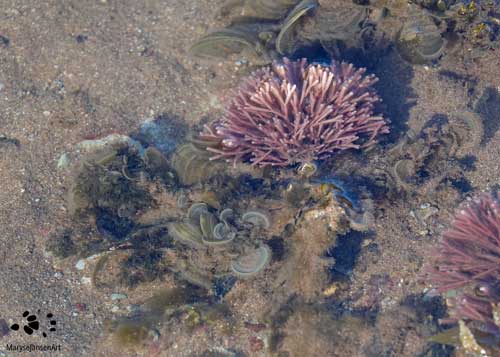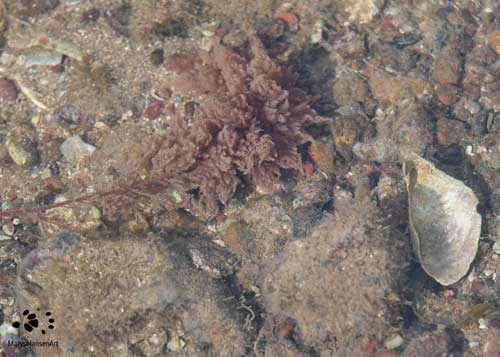Nature Photography with marysejansenart
Seaweed has fascinating applications that paint a brighter future

Seaweeds sensational??? What do you think when you hear the word ‘seaweed’? Maybe you think about sushi, about slimy heaps washed up on the beach, or about the giant kelp forests in which Harry Potter fights a massive battle? These were some of my own associations, but as I am exploring this rock pool ….. I begin to think more about this interesting life form.
Table of Contents
Seaweeds are not plants
Seaweeds look like non-woody plants, but they are not part of the plant kingdom. They are algae. To be more specific, they are macro algae. Macroscopic (as opposed to microscopic) means that these algae consist of multiple cells and are large enough to see with the naked eye.
Plants consist of ‘roots and shoots’. The shoots are the stems and leaves and the roots grow underground to keep the plants attached to the earth. Here’s a big difference with seaweeds: they don’t have roots! They have claw-like structures called ‘holdfasts’, with which they can attach themselves to hard surfaces like rocks. Holdfasts only serve as an anchor, whereas plant roots also absorb nutrients from the soil.
Algae are organisms that, like plants, are photosynthetic: they convert the energy of sunlight into a chemical energy which they use to grow. During this process they also absorb CO2 and produce oxygen. Basically they do function in the ocean in a similar way to which plants and trees function on land. The larger species grow in forests on the ocean floor and provide food, habitat and shelter to a myriad of creatures.
There are thousands and thousands of different species of seaweed and about most of these nothing is known! As much as us humans have studied, explored and discovered about nature, there are still many mysteries!

Rocky shores – a perfect ecosystem for seaweed
While exploring the rocky shore, I discover a variety of seaweeds that have become exposed due to the low tide. So you don’t even have to get wet to see them! That suits me fine as I don’t have the right gear for under water work. I marvel at all the different forms, shapes and colours of the seaweeds I see here. There are seaweeds in various shades of green, brown and red. As in the plant-world, there is huge variation in the shape of their leaf-like ‘blades’.
I also get glimpses of other inhabitants of this ecosystem, although most of them are pretty good at playing hide and seek! I see a couple of small crabs, some hermit crabs have taken up residence in the empty shells of other molluscs. There is one that is wandering around in the pretty shell of a mulberry whelk. There are tiny fish that shoot away in all directions when I approach and then disappear under the sand before I can actually see what they look like.
Pretty soon it becomes clear why these little fish, molluscs and crustaceans are so very good at hiding fast. I see an Australian White Ibis rummaging through the rock pools in search of a bite. With its long thin bill it can penetrate into the sandy bottom as well as explore holes in and gaps between the rocks and the occasional corals. Playing hide and seek is a matter of life and death!
Although I don’t see them today there will be a number of other bird species that fancy a similar diet. Think for instance about the Oystercatchers and many migratory birds such as Godwits, Whimbrels and the Eastern Curlews.
The seaweed itself also provides a food source for many marine organisms. The small crustaceans I see today will eat them, as well as sea urchins and sea turtles. Dugongs (large, herbivorous marine mammals) may eat them but only when there is not enough sea grass, which is their favored food. In this area I notice some sea grass as well.
Seaweed as a food source
And yes, thinking back to the sushi, people can eat them too! And not only in Japan is this common. Amongst Aboriginal Peoples from coastal areas, they have long been a common food source (bush tucker). Seaweeds are very healthy and full of vitamins and minerals. Although, as with most things, eating too much may cause problems, so moderation is key! It is not known if all seaweed species are edible for us as there is just not enough information about all the thousands of species. So I would take care and only eat seaweeds when offered for consumption by knowledgeable people.
A bit more unexpected is the fact that seaweed is also consumed by ruminant livestock (cattle, sheep and goats)! It has been used for a long time and has been found to improve the health and immunity of the animals, as well as aid in better growth.
Seaweed has potentials to create positive changes in the world
Dr Alexandra Campbell from the USC (University of the Sunshine Coast) in Queensland is an ecologist with a specialization in seaweed and she says that apart from being a great food source, seaweed has many potentials to create positive changes in relation to climate change and biodiversity loss.
For instance, let’s have a look at this livestock feed. Dr Alexandra Campbell states that the world wide ruminant livestock are responsible for roughly 10% of all greenhouse gas emissions and in Australia that number is even higher: closer to 15%. They produce methane which is a much more potent and problematic greenhouse gas then CO2 already is, so this is a big problem.
The methane is particularly produced when the animals burp. It has been found that a particular compound in a particular seaweed, when ingested by the animals in very small amounts, stops them from burping methane almost completely! Now I think that is sensational! How about you?
This particular seaweed is called Red Sea Plume (Asparagopsis taxiformis). It’s a Red Algae and occurs naturally in Australia in tropical and subtropical waters. It grows on the hard surfaces of rocky-reef areas, in intertidal as well as subtidal zones. Where I am standing right now would be the perfect place: an intertidal zone of a rocky shore in subtropical waters!
I find my way along the rocky surfaces as the tide begins to come back in and to my great excitement there it is! Swaying gently in the shallow water, which really does it justice! A small, but perfect specimen of Asparagopsis taxiformis! Showing up in just the right moment to illustrate my story about this beautiful example of how creative minds can help create a better situation on our planet!
Check out more solutions here and be inspired.

If you are interested in purchasing a print of ‘Seaweeds’ or would like to see what the image looks like on the various merchandise products, please head to my shop. If you’d prefer ‘Oyster Thief’, click shop here. And for Red Sea Plume, click here.
Join me on my explorations of the rocky shores in the latest episode of ‘Come for a walk in the Australian Bush’:


